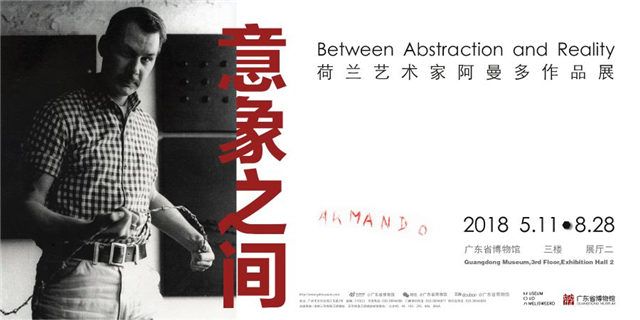A poster of the exhibition. [Photo/Guangdong Museum]
Without traveling all the way to the Netherlands, but right here at your doorstep in Guangzhou, you can now enjoy fascinating works by Armando, one of the greatest Dutch artists.
Born in Amsterdam and grew up in Amersfoort, Armando is one of the greatest and most important Dutch post-war artists. Hailed as a modern-day uomo universale, he is a painter, sculptor, writer, draughtsman, documentary filmmaker and theatre maker.
His creations involve a variety of fields, such as painting, sculpture, music, poetry and novel. His works have been exhibited and collected by many famous museums.
The exhibition “Armando: Between Abstraction and Reality” is the first museum exhibition of Armando’s works in China. That is remarkable for an artist whose work is part of countless museum and private collections across the globe. Including 70 pieces (sets) of paintings and sculptures, the exhibits are provided by Museum Oud Amelisweerd, a knowledge center for Armando’s life and works.
The exhibition features works in several disciplines (paintings, drawings and prints, sculptures and artist books) as well as his written works and films. It is divided into the five most important themes: Melancholy, Time and Remembrance, Beauty and Evil, The Places, Aggressor and Victim and Sources of Inspiration. A sixth theme shows the subtle similarities between Armando’s landscapes and paintings by 18th-century Chinese artist, as these were presented in the exhibition Made in China – Armando & Masterpieces from the Qing Dynasty in MOA | Museum Oud Amelisweerd.
The exhibition will be accompanied by a catalogue that included articles by amongst others Wenling Ren of the Guangdong Museum, Yvonne Ploum, director of MOA and Roelof Jan Minneboo, curator of MOA. The catalogue is published by the Guangdong Museum.
The exhibition “Armando: Between Abstraction and Reality” is held at Guangdong Museum. [Photo/Guangdong Museum]
Period: May 11 to August 28, 2018
Opening hours: 9:00-17:00, closed on Mondays
Venue: Exhibition Hall 2, 3rd Floor, Guangdong Museum
Add.: No. 2 Zhujiang Dong Lu, Zhujiang New Town, Tianhe District, Guangzhou (广州市天河区珠江新城珠江东路2号)
Nearby metro station: Zhujiang New Town station, Line 3 or Line 5;
Bus: No.40, No.44, No.183, No.293, No.886, No.886A;
Admission: Free admission tickets can be obtained from the Ticket Office of Guangdong Museum from 8: 50 a.m. to 4 p.m. Valid ID is required for one person to get one ticket. Tickets are valid on the day of issue only.
Further reading: Armando and China
In 1986, Armando joined a group tour to China and visited Hong Kong, Shanghai, Beijing, and the upper reaches of the Yangtze River. When he was back in the Netherlands, he wrote two articles (“De Groep” and “Peking Onder de Grond”) about it for the Dutch newspaper NRC Handelsblad.
In January 1988, China’s Lijiang Publishing Ltd. edited and published Modern Dutch Poetry, which includes six poems written by Armando. In August 2005, Guangxi Normal University Press published a second edition and it won the Best Jacket/Cover Design in the first Chinese Government Award for Publishing in November 2007.
Armando’s artworks exhibited in China
From November 2014 to July 2015, the touring exhibition “Art Space Germany: Kunstraum Deutschland” was shown in Beijing, Nanjing and Wuhan, showcasing the works of thirteen migrant artists who live in Germany and their influence on German art society, including five Armando’s paintings in three sets.
From October 2016 to January 2017, the exhibition “Same? Not the Same” in Wuhan featured 23 pieces of art works created by twelve artists from six different countries, two of which were Armando’s paintings.
From September 2017 to March 2018, the exhibition “Made in China – Armando & Masterworks from the Qing Dynasty” in Guangzhou compared Armando’s works with Chinese 18th century landscape paintings. After seeing the exhibition in person, Armando was indeed surprised by the similarities between his works and those of Li Jian, a native of Guangdong and a famous painter in the Qing Dynasty.
(Author: Monica Liu; Editor: Olivia Yang)



















